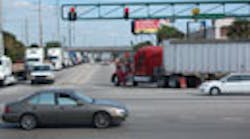Though the global economic downturn is being tagged as “the biggest factor” in a record drop in annual car-truck crash fatalities, federal officials and industry executives alike believe the steep decline shows that trucking is making serious strides when it comes to safety improvements.
Crash data compiled by the National Highway Traffic Safety Administration (NHTSA) indicates that the truck-involved fatality rate on the nation’s roadways declined 12% last year in comparison with 2007, with truck-related crash fatalities dropping from 4,822 in 2007 to 4,229 in 2008.
“This is great news; it’s very encouraging,” Rose McMurray, acting deputy administrator for Federal Motor Carrier Safety Administration (FMCSA) told FleetOwner. “Though the U.S. economic downturn is the biggest factor behind this drop in fatalities – as freight volumes are down, thus reducing truck miles driven – we still think its compelling evidence that safety is becoming a more important priority in trucking.”
For example, McMurray pointed to NHTSA’s findings that the number of truck occupant deaths decreased 16% last year – from 805 in 2007 to 677 in 2008 – which she believes directly correlates to increased safety belt usage among commercial drivers. FMCSA’s data noted that safety belt use by drivers of medium- and heavy-duty commercial vehicles increased to 72% in 2008, up seven percentage points from 65% in 2007.
“That increase in safety belt usage is reducing the ejection of truck occupants during a crash – and we think that is but one example of how the safety initiatives on the part of government, law enforcement, and the industry are paying off,” McMurray stressed.
More critically, she noted, a close review of 600 fewer truck-involved fatalities from 2007 to 2008 shows that most the gains came from reductions in fatalities involving the occupants of other vehicles.
“The efforts of the states to increase enforcement of aggressive drivers of passenger vehicles and raise public awareness of the dangers of driving near and around commercial vehicles seem to be paying dividends,” McMurray said. “Initiatives such as the Ticketing Aggressive Cars and Trucks (TACT) program are helping to make the general driving public more aware of the safe ways to interact with trucks and to provide large vehicles with more room and maneuverability.”
Overall, the number of people killed in motor vehicle crashes in the U.S. decreased 9.7% last year; from 41,259 in 2007 to 37,261 in 2008, the lowest level since 1961, said NHTSA. Substantial declines occurred in virtually every major category, led by declines in passenger car occupant fatalities which dropped for the sixth year in a row, reaching the lowest level since the U.S. Department of Transportation (DOT) began keeping records, the agency noted.
Continuing this trend, the January-March 2009 estimate of 7,689 deaths represents a 9% decline from a year ago; the 12th such consecutive quarterly decline. The fatality rate for the first quarter of 2009 reached 1.12 fatalities per 100 million vehicle miles traveled. Yet preliminary data collected by the Federal Highway Administration (FHWA) indicates reduced driving is main reason for the drop, as total vehicle miles traveled (VMT) during the first three months of 2009 declined by about 11.7 billion miles.
On the positive side, light truck occupant fatalities fell for the third straight year, while alcohol-impaired fatalities also declined by more than 9% over 2007. However, motorcycle deaths continue to increase, climbing for the 11th straight year and now accounting for 14% of all highway fatalities, NHTSA found.
“While the number of highway deaths in America has decreased, we still have a long way to go,” noted Transportation Secretary Ray LaHood in a press statement.
Still, truckers are taking heart from the major reduction in highway fatalities related to their occupation. “This achievement is great for all highway users,” said Bill Graves, president and CEO of the American Trucking Associations (ATA). “We must build upon this and look toward long-term improvements.”




